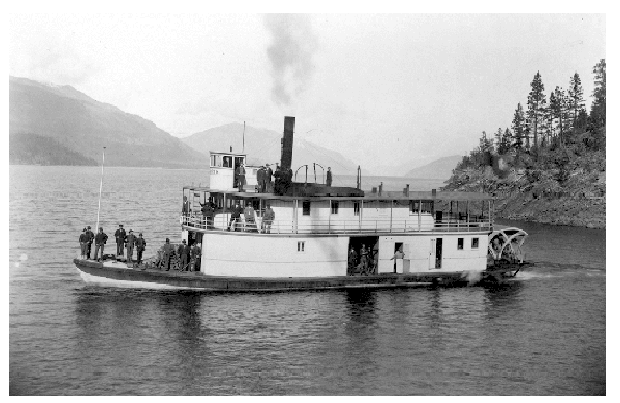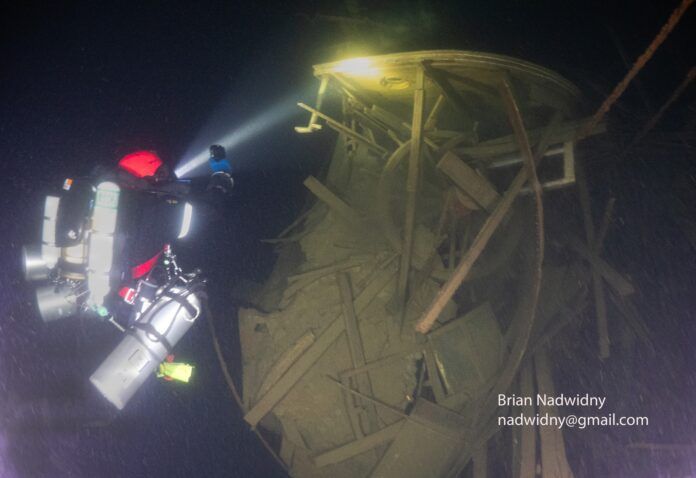For just the second time since it sank on Kootenay Lake in 1898, divers have visited the wreck of the SS City of Ainsworth.
“This shipwreck was appealing because no one had dived on it since 1997,” said Brian Nawidny, one of four people to touch the remains of the doomed ship last week. “Nobody really knew what was going on with it. Was it still there? Was it still intact? It was kind of a challenge.”
The sternwheeler was launched in 1892 and had many problems before its final voyage on a stormy night that claimed the lives of three passengers and six crew. It remains the worst marine disaster in recorded West Kootenay history.
The wreck was first located in 1990, in about 360 feet (110 metres) of water off Crawford Bay, and is a protected site under the Heritage Conservation Act. In 1997, Bart Bjorkman of Creston and John Chluski became the first divers to successfully reach it, in what was regarded as the deepest dive in Canada.
Recreational divers are typically limited to 100 feet (30 metres), Nawidny explained, and going down that far requires extra training and gear. They also had to adjust their breathing gases.
“We couldn’t breath air at that depth because of considerations for oxygen and nitrogen,” he said. “We were breathing a mixture of 10 per cent oxygen and 70 per cent helium and we used what are called rebreathers, a closed circuit loop. You keep breathing the same gas over and over.”
Reaching the wreck only took five or six minutes. Once at lake bottom, they had 10 minutes to survey the site before they had to come back up. Resurfacing is the arduous part: decompression takes up to two and a half hours.
Given the narrow window they had to work with, Nawidny says he was too busy to be excited. “As soon as I hit the bottom, I was into picture and video mode, trying to get as much footage as I could in that short period. It wasn’t until after that I was pretty excited that we’d done it.”
Nawidny was involved in previous efforts in 2011 and 2019 to photograph the Ainsworth with remotely operated submersibles. The first effort only got a little footage before the sub broke. The more recent expedition also produced less-than-stellar images and Nawidny says they knew they would have to visit in person to get something better.
Over a week, they did three successful dives using two divers at a time. Each day, one team attempted to dive on the wreck while the other stayed on the surface as support.
RELATED: Film crew explores wrecks on Kootenay Lake
They’re now reviewing footage taken with two GoPros and another specialized camera to see what stands out. Thanks to improved technology, Nawidny expects they will be able to spot a lot more things than the first images taken over 25 years ago. He said they plan to return next year with a better idea of what parts of the ship to focus on.
One thing was immediately apparent, however: “The wreck has significantly deteriorated since 1997. It’s starting to fall apart. There’s silt build-up on it. It’s a good thing we got on it when we did.”
One advantage they enjoyed was that they didn’t have to invest as much time as previous crews in locating the wreck. With modern sonar it’s now fairly easy to find, he said, so while they missed the ship on their first dive, they repositioned their boat and dropped anchor within 30 feet (nine meters) of the site.
They waited until late August to do the dive because that’s when the water warms up. Nawidny said in winter and spring it’s too cold: 4C from top to bottom. But at this time of year, it’s about 18C from 30 feet up, which is where the divers spent most of their time decompressing. Visibility is also better in late summer.
Nawidny, who splits his time between Cranbrook and Ainsworth, belongs to the Kootenay Lake Historical Society and said it’s important to him “to solve the mysteries of what’s going on with that wreck for them.”
The other divers were Johnny Ryan (Airdrie, Alta.), Alan Drake (Vancouver), and Glenn Farqhar (Vancouver). Also on the team were three people from Edmonton: support diver Terina Hancock, boat skipper and surface support John McCuaig, and Cathie McCuaig, who looked after “meals and holding down the fort.”








